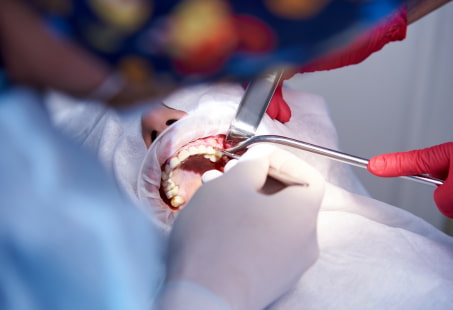A sinus lift is a dental procedure that involves the lifting of the sinus membrane for the placement of a bone graft. The goal of this surgery is to create sufficient bone structure to support a dental implant. Without enough bone, there’s the potential of the implant drilling into the sinus itself.
There are different ways in which this procedure can be done. And while you may more commonly hear about getting an implant a while after a sinus lift, it’s also possible to get an implant at the same time as a sinus lift. In any case, there are some important considerations about this procedure. In this guide, you’ll learn more about what a sinus is, its procedure, recovery, risks, and cost.
What Is A Sinus Lift?
Sinus lift refers to the elevation of the sinus membrane in the upper jaw to increase the height and width of the bone underneath. Also known as sinus augmentation, the procedure is fairly common, and according to the American Academy of Periodontology, it can improve the likelihood of “successful implants that can last for years to come.”

As for the bone graft needed for sinus lift, it can come from different sources, such as:
- Autogenous/autograft – bone is taken from a different part of your own body
- Xenograft – a bone graft is taken from animals, including cows and pigs, among others
- Allogenic – bone is obtained from a cadaver
- Synthetic – a synthetic bone substitute is used
As per a 2023 study published in Cureus, there are two ways in which a sinus lift can be done: the one-stage or the two-stage technique. In the former, the dental implant is placed at the same time as the sinus is lifted and in the latter, initially, the bone is augmented; only after the “necessary bone volume” has been achieved that the implants are placed into the bone.
If you’re getting an implant at a later date, there may be a delay of 4-9 months or even a year. The timeline can vary between patients.
When Do You Need A Sinus Lift?
Your dentist may recommend a sinus lift if you want to get implants in your upper jaw but don’t have sufficient bone there. The latter can be a result of different factors, such as:
- Gum disease
- Tooth loss
- Ageing
- Health problems
Therefore, these factors may necessitate a sinus lift as without enough bone, your implant won’t have a proper space to stick into.
What Is The Procedure For A Sinus Lift?
After you arrive at the clinic, your procedure will begin with the administration of anaesthesia. Usually, it is local, but it can also be general, depending on the complexity of the surgery. After it takes effect, your dentist may:
- Make an incision in your gum tissue to expose the underlying bone
- Cut a piece of the jawbone and lift it into the sinus cavity
- Fill the space underneath the membrane with the bone graft
- Stitch the gum tissue back up

As mentioned above, there are a number of different ways in which this procedure can be done. For instance, it may be done vertically through the hole that is drilled for the dental implant. However, it can also be done laterally, where the dentist will approach the target area from the side. It may depend on how much bone you need.
Sinus lift is usually an outpatient procedure, so you can return to your home/hotel the same day. It also doesn’t take too long. The entire sinus lift procedure may be done in an hour or so (may take less), but it can vary according to the complexity of the surgery.
How Long Does A Sinus Lift Take To Heal?
It can take a couple of weeks or so for you to start feeling normal again after your sinus lift surgery. Your surgeon will likely prescribe you medicines, so make sure to take them as prescribed. Aftercare instructions can also include:
- Avoiding blowing the nose
- Sneezing with the mouth open if you have to
- Avoiding rinsing and spitting
- No sucking through a straw
- No smoking (preferably, quitting it altogether) and drinking
- Not engaging in strenuous activities, including exercise
- Eating cold, soft foods (e.g. yoghurt, ice cream, pudding)
- Refraining from consuming hot, spicy, hard, carbonated, and/or acidic foods and beverages (you may also be advised to eat from the other side of the mouth)
Your dentist will also give you specific instructions on where to brush your teeth and after how much time. You may also be advised to use cold packs, but for that as well make sure to follow your dentist’s instruction to not further traumatise the surgical area.
Keep in mind that you can also experience post-op side effects like nose/mouth bleeding, swelling, pain and bruising. You should be informed of a normal recovery timeline, and if yours isn’t progressing according to it, make sure to get in touch with the dentist.
Are Sinus Lifts Dangerous?
While a sinus lift is considered a safe procedure, it does come with certain risks. According to the Cureus research mentioned above, sinus membrane perforation is the most common complication that occurs during sinus lifting. Others that can occur after surgery include:
- Infection
- Sinusitis (inflammation of the sinuses)
- Loss of the graft
- Exposure of the graft
- Exposure of the membrane
- Swelling
- Bleeding
- Formation of seroma (fluid build-up)

In case your sinus membrane is torn, your surgeon will repair it during the surgery. Depending on how it is, you might need to heal from it first before having a sinus lift.
How Much Is A Sinus Lift?
In the UK, a sinus lift might cost you £1,200 to £5,000. However, the overall cost can vary depending on:
- Where the bone graft will come from
- The type of anaesthesia you will receive
- How complicated the procedure is
- How experienced your dental surgeon is
- Where their clinic is located
Also, keep in mind that this price is unlikely to include that of your implant. The cost of a single implant can start somewhere around £2,000, but it can vary.
If you’re looking for a more affordable option, you can consider getting a sinus lift in Turkey, where it may start around £500, and the implant itself may also cost you about the same.
Conclusion
If you’re thinking about getting dental implants, your dentist will first have to check whether or not you have enough bone for the successful placement of an implant. If that’s not the case for the back of your upper jaw, a sinus lift surgery can be helpful in restoring the proper functioning of your mouth.
It’s considered a safe and effective procedure as well, but it’s important that you do your research to find a medical professional who is experienced and qualified to perform this surgery. Additionally, during your consultation, make sure to discuss all the potential pros and cons of this procedure.
Reviewed and approved by Dr Izbel Aksit
FAQs
How painful is a sinus lift?
A sinus lift is performed under anaesthesia, so you should not experience pain during the surgery. However, you may experience post-op pain, and your dentist will likely prescribe medication to alleviate it.
How long after sinus lifts can you get dental implants?
You may be able to get a dental implant at the same time as your sinus lift. But if that’s not the case, you might have to wait for 4-12 months.
Can a sinus lift cause headaches?
Sinusitis is a post-op complication of sinus lift, one of the symptoms of which is a headache. In any case, it’s important that you consult your dentist if you’re experiencing it.
Can you fly after a sinus lift?
You may be advised against air travel for a few weeks after the sinus lift procedure. If you’re travelling abroad for this surgery, make sure to discuss it with your dental surgeon beforehand, so you have a clear timeline.
